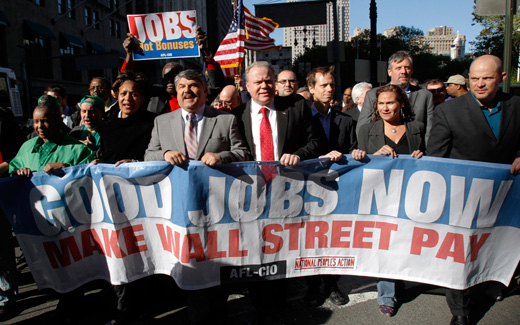
This is Part 2 of an article by John Bachtell, chair of the Communist Party, on Left strategy and the 2016 elections. It is adapted from an article first published in Platypus Review #85. Part 1 can be read here.
Broad unity and multi-class alliances
As mentioned previously, the coming-to-power of the ultra-right in 1980 radically changed the dynamics of political struggle in our country. What has emerged over the last four decades is a broad understanding of the danger posed by the right, and with it a loose, multi-class alliance which includes the labor movement, communities of color, and democratic reform movements of all kinds. This alliance is multi-generational, and it unites left and center political currents, as well as a section of capital that is in conflict with the extreme right.
For those who recoil at the notion of a multi-class alliance, consider that our nation’s history is replete with such examples. Recall the fight against slavery and the alliance of northern industrial capitalists, slaves, working masses, and abolitionists. Or the struggle against fascism, the splits in the U.S. ruling class, and the multi-class alliance built to defeat it in the 1930s and 40s. Today, splits in the ruling class have appeared over the climate crisis. A section of capital who sees an existential threat to capitalism is objectively aligned with the environmental movement.
So this is nothing new. In fact, for Lenin, building multi-class alliances and exploiting fissures in the ruling class was a given. The Bolsheviks advocated alliances between Russia’s nascent proletariat, its vast peasantry, and the small bourgeois class to overthrow the czar.
Class struggle within
We have to play the cards dealt as we fight to change the rules of the game. Politics in America is conducted in a two-party, winner-take-all system, institutionalized since the Jacksonian era. Third parties have arisen during times of sharp crisis or political realignment, as the Republican Party did in the fight against slavery. In such instances, they may supplant one of the two dominant parties, but third parties failing to make this breakthrough have never lasted long. Until radical reform allowing parliamentary democracy or fusion politics, the prevailing circumstances don’t allow for more than two viable national parties.
All parties reflect coalitions of class and social interests, and the Democrats and Republicans are no different. They are vehicles through which these forces fight for their agendas. In the battle being fought in the political realm, some see no difference between the Democratic and Republican parties, painting them with a broad brush as creatures of Wall Street. For sure, both are dominated by corporate interests.
But we can’t leave it there; real life is far more complex. For starters, both have vastly different social compositions. While the Republican Party is led by the most reactionary sections of capital, but also includes extreme right-wing elements like the Tea Party, white supremacists, climate deniers, and Evangelicals.
Meanwhile, in the Democratic Party there is organized labor, African Americans, Latinos, other communities of color, the women’s, youth, and a range of other social movements. A wide spectrum exists in the Democratic Party including a substantial current of self-described democratic socialists. These constituencies exert influence and hold leadership positions at various levels. They still see the Democratic Party as the most viable means to advance their agendas within the party system at this moment. Any establishment of a people’s party requires these very forces at its core and until they are prepared to bolt, it is not yet a viable prospect.
The Democrats’ multi-class constituency, however, is beset with internal contradictions. The class struggle rages within, between the Wall Street and progressive wings. Establishment and machine elements clash with independent forces. This is reflected in part in the competition between Clinton and Sanders, but similar clashes play out on a local level, such as the 2015 Chicago mayoral race that pitted Chuy Garcia and independent candidates against Rahm Emanuel and the Democratic machine.
There may be cooperation in the fight against the extreme right, but the class struggle is never suspended; these same forces battle daily on economic, political, and ideological fronts. Extreme wealth concentration will continue to deepen these class divisions and tensions within the Democratic Party coalition. A “political revolution” can transform politics if labor, its allies, and the broad left put their stamp on the multi-class alliance, shape its politics, and frame the issues debated for the elections.
Such is the nature of class contradictions.
Majorities make change
Any successful “political revolution” will be fueled by ongoing shifts in public attitudes. Majorities of Americans now favor taxing the rich, raising the minimum wage, immigration reform, abortion rights, marriage equality, criminal justice reform, and action to curb the climate crisis.
A political revolution is based on the idea that majorities make change. It is not enough for majorities to believe in an idea, they must actively fight for it. While important shifts against the ultra-right have taken place on key issues, the electorate is still deeply divided, with a substantial section misled, disillusioned, and disengaged. To be transformative, a movement must have an organized expression in every community. It must fight uncompromisingly against racism, sexism, homophobia, transphobia, anti-Muslim and anti-immigrant attacks, and all efforts to divide.
White working-class communities are considered a key demographic for the GOP and are targets of the worst kind of racist and reactionary ideas. They cannot be abandoned to the embrace of the extreme right and its ideology of hate. A political revolution calls for a 50-state strategy including turning red states and districts blue and defeating the GOP in its stronghold – the “Deep South.”
Political independence
The loose coalition that presently aligns itself with the Democratic Party – including organized labor; organizations and movements in communities of color; the women’s, immigrant, LGTBQ, student, and environmental movements – is in constant motion, changing in response to real life experiences.
Intertwined with the fight against the right is the ongoing process of building political independence. And it is here that I disagree most strongly with both Doug Henwood and Gregor Baszak, our two giant-slayers from the lead-off to this article. Far from being liquidated into the Democratic Party, I see the labor-led democratic movement becoming increasingly assertive, growing in influence, and establishing politically independent structures both inside and outside the Democratic Party.
The AFL-CIO no longer gives directly to the DNC but funds its own voter education and mobilization efforts. It develops its own strategic outlook, and is increasingly training and running trade union activists for public office. There are rich examples of the growth of independent structures including MoveOn, Democracy for America, Progressive Democrats of America, and the Working Families Party.
Politically independent movements are beginning to take root in Chicago. Developments include the establishment of several independent political organizations working in and outside the Democratic Party and an increasing number of independent challenges to machine candidates. This process is in its early stages and foreshadows the eventual establishment of a real people’s party.
A defeat of the right – and especially winning the Senate and House – could constitute a political turning point, creating new possibilities for advancing the struggle. It would create more favorable circumstances to reform the electoral system itself, build the labor movement, and broaden and deepen coalitions.
Out of decisive turning points come new stages of struggle, including for more radical reforms.
Post-election
If either Sanders or Clinton are elected, their administrations will face unrelenting pressure and obstruction from (in Sanders’ case) Wall Street, the military-industrial complex, the fossil fuel industry, right-wing think tanks, the mass media, and, of course, right-wing elements in the oligarchy. In addition, the Democratic Party’s neoliberal establishment will reassert itself in the post-election period, casting aside elements of the program upon which the election pivoted.
Contrary to what Henwood or Baszak might have us believe, Clinton and Sanders aren’t the giants we need to slay.
What is important is that voters and movements remain engaged after the elections. When President Obama was elected in 2008 voters thought they had done their duty and went home. The void was filled by GOP obstruction and the Tea Party. Low voter turnout in 2010 and 2014 led to GOP control of Congress and statehouses across the country.
The challenge before labor, communities of color, women, youth, the LGBTQ community, climate justice and other democratic forces is to continue to build the biggest, broadest, most diverse and tactically mature movement possible to win in 2016 and set the stage for bigger victories ahead.
Photo: AFL-CIO President Richard Trumka (3rd L) marches with Jack Ahern, President of the NYC Central Labor Council (3rd R) and other leaders at a rally in New York, N.Y. | AP










